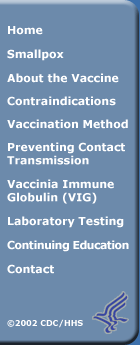|
A normal primary vaccination appears as a papule in 3-4 days, and
rapidly progresses to a vesicle with the surrounding erythema by the
5th-6th day. The vesicle center becomes depressed and
progresses to a well-formed pustule by the 8th-9th day. By the
twelfth day, or soon thereafter, the pustule crusts over forming a brown scab, which
progresses from the center of the pustule to the periphery.
After 2.5 to 3 weeks, the scab detaches and a well formed scar
remains.
Normal Reaction Time
| Day |
Description
|
|
| 0 |
Vaccination |
|
| 3-4 |
Papule |
|
5-6
|
Vesicle with surrounding erythema →
vesicle with depressed center |
|
| 8-9 |
Well-formed pustule |
|
| 12+ |
Pustule crusts over → scab
|
|
| 17-21 |
Scab detaches revealing scar |
|
Rarely, in some first-time or distantly vaccinated (re-vaccinee) individuals, seemingly appropriate vaccination techniques may result in no reaction. One should assume that the individual is not immune and repeat attempts should be made to achieve a major response or “take”. At least one repeat vaccination with a different vaccine vial should be given, switching skin sites on the same arm or using the other arm. If the second vaccination is unsuccessful, consultation should be obtained to determine if the vaccination technique was flawed (primary or re-vaccinee), the vaccine was non-viable (first-time or re-vaccinee), or the vaccinee still had immunity from a previous vaccination (re-vaccinee).
Systemic symptoms: Systemic symptoms are expected and usually occur between 8 -10 days after vaccination when the vaccine site reaction reaches the peak of the inflammatory response. These include:
• Soreness at the vaccination site
• Intense erythema ringing the vaccination site
• Malaise
• Lymphadenopathy (local)
• Myalgia, headache, chills, nausea, fatigue
• Fever
Historically, the occurrence of these normal reactions varied considerably from study to study as shown in ranges demonstrated in the table below. They also varied between primary vaccinees (higher rates of symptoms) and re-vaccinees (lower rates of symptoms).
| • |
Lymphadenopathy
|
25.0 - 50.0 % |
| • |
Myalgia, headache, chills, nausea, fatigue |
0.3 - 37.0 % |
|
•
|
Fever > 37.7° C
|
2.0 - 16.0 % |
|
|
A recent NIH study, evaluating diluted and undiluted
smallpox vaccine in adults receiving their first vaccination, reported
the following symptom rates during the 14 days following vaccination.
These rates are similar to those seen in previous studies.
| • |
Lymphadenopathy |
54% |
| • |
Myalgia and chills, |
20% |
| • |
Headache |
40% |
| • |
Nausea |
20% |
| • |
Fatigue |
50% |
| • |
Fever > 37.7° C |
10% |
|
|
|
|


